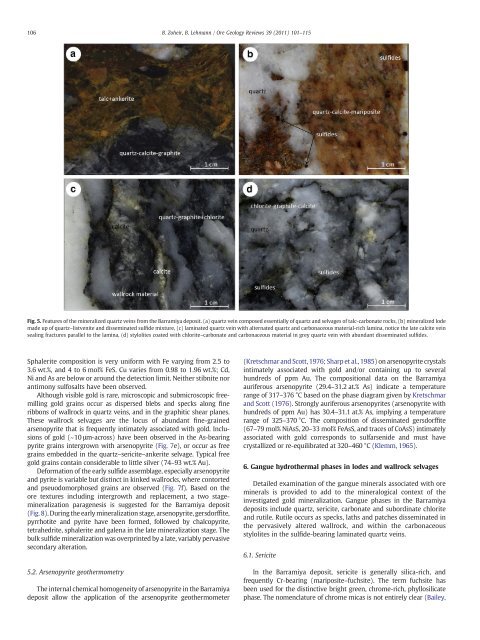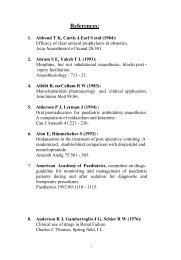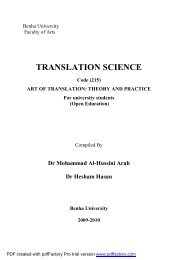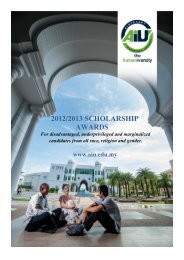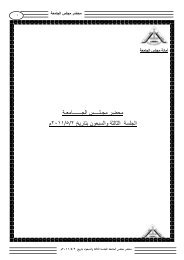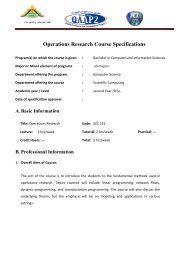Basem Ahmed Zoheir_Barramiya, OGR_2011.pdf
Basem Ahmed Zoheir_Barramiya, OGR_2011.pdf
Basem Ahmed Zoheir_Barramiya, OGR_2011.pdf
You also want an ePaper? Increase the reach of your titles
YUMPU automatically turns print PDFs into web optimized ePapers that Google loves.
106 B. <strong>Zoheir</strong>, B. Lehmann / Ore Geology Reviews 39 (2011) 101–115<br />
Fig. 5. Features of the mineralized quartz veins from the <strong>Barramiya</strong> deposit. (a) quartz vein composed essentially of quartz and selvages of talc-carbonate rocks, (b) mineralized lode<br />
made up of quartz–listvenite and disseminated sulfide mixture, (c) laminated quartz vein with alternated quartz and carbonaceous material-rich lamina, notice the late calcite vein<br />
sealing fractures parallel to the lamina, (d) stylolites coated with chlorite–carbonate and carbonaceous material in grey quartz vein with abundant disseminated sulfides.<br />
Sphalerite composition is very uniform with Fe varying from 2.5 to<br />
3.6 wt.%, and 4 to 6 mol% FeS. Cu varies from 0.98 to 1.96 wt.%; Cd,<br />
Ni and As are below or around the detection limit. Neither stibnite nor<br />
antimony sulfosalts have been observed.<br />
Although visible gold is rare, microscopic and submicroscopic freemilling<br />
gold grains occur as dispersed blebs and specks along fine<br />
ribbons of wallrock in quartz veins, and in the graphitic shear planes.<br />
These wallrock selvages are the locus of abundant fine-grained<br />
arsenopyrite that is frequently intimately associated with gold. Inclusions<br />
of gold (~10 μm-across) have been observed in the As-bearing<br />
pyrite grains intergrown with arsenopyrite (Fig. 7e), or occur as free<br />
grains embedded in the quartz–sericite–ankerite selvage. Typical free<br />
gold grains contain considerable to little silver (74–93 wt.% Au).<br />
Deformation of the early sulfide assemblage, especially arsenopyrite<br />
and pyrite is variable but distinct in kinked wallrocks, where contorted<br />
and pseuodomorphosed grains are observed (Fig. 7f). Based on the<br />
ore textures including intergrowth and replacement, a two stagemineralization<br />
paragenesis is suggested for the <strong>Barramiya</strong> deposit<br />
(Fig. 8). During the early mineralization stage, arsenopyrite, gersdorffite,<br />
pyrrhotite and pyrite have been formed, followed by chalcopyrite,<br />
tetrahedrite, sphalerite and galena in the late mineralization stage. The<br />
bulk sulfide mineralization was overprinted by a late, variably pervasive<br />
secondary alteration.<br />
5.2. Arsenopyrite geothermometry<br />
The internal chemical homogeneity of arsenopyrite in the <strong>Barramiya</strong><br />
deposit allow the application of the arsenopyrite geothermometer<br />
(Kretschmar and Scott, 1976; Sharp et al., 1985) on arsenopyrite crystals<br />
intimately associated with gold and/or containing up to several<br />
hundreds of ppm Au. The compositional data on the <strong>Barramiya</strong><br />
auriferous arsenopyrite (29.4–31.2 at.% As) indicate a temperature<br />
range of 317–376 °C based on the phase diagram given by Kretschmar<br />
and Scott (1976). Strongly auriferous arsenopyrites (arsenopyrite with<br />
hundreds of ppm Au) has 30.4–31.1 at.% As, implying a temperature<br />
range of 325–370 °C. The composition of disseminated gersdorffite<br />
(67–79 mol% NiAsS, 20–33 mol% FeAsS, and traces of CoAsS) intimately<br />
associated with gold corresponds to sulfarsenide and must have<br />
crystallized or re-equilibrated at 320–460 °C (Klemm, 1965).<br />
6. Gangue hydrothermal phases in lodes and wallrock selvages<br />
Detailed examination of the gangue minerals associated with ore<br />
minerals is provided to add to the mineralogical context of the<br />
investigated gold mineralization. Gangue phases in the <strong>Barramiya</strong><br />
deposits include quartz, sericite, carbonate and subordinate chlorite<br />
and rutile. Rutile occurs as specks, laths and patches disseminated in<br />
the pervasively altered wallrock, and within the carbonaceous<br />
stylolites in the sulfide-bearing laminated quartz veins.<br />
6.1. Sericite<br />
In the <strong>Barramiya</strong> deposit, sericite is generally silica-rich, and<br />
frequently Cr-bearing (mariposite–fuchsite). The term fuchsite has<br />
been used for the distinctive bright green, chrome-rich, phyllosilicate<br />
phase. The nomenclature of chrome micas is not entirely clear (Bailey,


